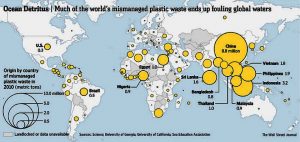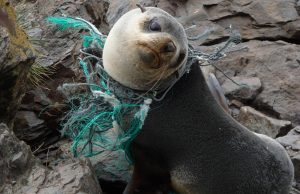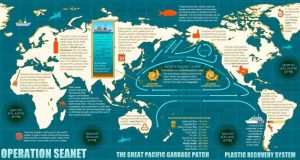Posted by Brian on January 1, 2018 · Leave a Comment
by S. Oram (new blogger)
Where do you throw your plastics and trash when you are done with it? I would hope you say you RECYCLE ! Because just throwing that container away by mixing it with the normal trash or discarding out the window creates problems. Part of this problem is POLLUTION. This pollution creates visual aesthetic issues, but also damages habitat and threatens the land, air, and sea animals. Did you ever stop and think about how these things can affect the animals outside? Most plastic waste comes from third world countries especially in China, but we can still make a difference.
 https://goo.gl/images/38xfsv Online Source –
https://goo.gl/images/38xfsv Online Source –
In the 1970s, the National Academy of Sciences estimated about 45,000 tons of garbage and waste was being tossed and thrown in the ocean. Since initial estimate, it has gotten even worse. Many people throw things in the ocean and don’t think about the animals in it or the other uses downstream. The materials can get wrapped around the animals or some of the animals eat. The animals become hurt, sick, and die. Littering can kill marine life and destroy habits. Some people don’t stop to think about the animals and their safety. Over 100,000 marine mammals and 1 million sea birds are killed each year from plastic pollution and 6 million tons of debris, i.e., a ton is 200 lbs , enters the ocean each year. It is time to say – Enough!

Sad there is no reason to create this type of pain and suffering.
Did you know it can take up to 450 years for plastic bottles to decompose? This does not appear to be true. “Scientists Thought It Took Thousands of Years for Plastic to Decompose – It May Only Be Decades” and “A more recent study revealed that PET degrades more rapidly than previously thought in ocean water due to the presence of metal ions in the water. Fifty percent degradation was said to occur in 4.5 years and 100% degradation in 72 years.”
Where is most of this plastic? (Operation Seanet)

Here is a list of wastes that go in the ocean and how long it takes to decompose.
Foam cups and tin cans – up to 50 years.
Plastic bottles depending on type and environment could be up to 450 years (Source)
Fine fishing net up to 600 years (much longer for heavier nets).
Cigarette butts- 1 – 5 years.
Plastic bags- 10 – 20 years (Some putting this debris in a plastic bag is not good enough) . The bags breakdown and this it may take 100s of years for the content to decompose.
SO – Simply Bagging the Trash is Not a Solution and Putting the Plastic in a Landfill is the Wrong Choice. We must make every effort to recycle, reuse, and then put our young minds together and help to clean up our oceans, beaches, and landscapes and develop better solutions.
My call to action:
- Please think twice before littering and think twice before throwing stuff away, especially plastic bottles.
- Try Going Bottleless –We tried and we saved money.
- Pick up litter and Recycle – Participate in local clean up events.
- Try to kick the plastic habit.
- Check out Operation – Seanet
other Articles
PFAS Cycle – https://shop.knowyourh2o.com/blogs/news/pfas-and-forever-chemicals-a-new-man-made-cycle-the-pfas-cycle-that-must-be-broken
Plastics and the Environment – Debunking Myths and Responsible Practices
Wildlife and Lead Poisoning – Lead is not Just a Problem for Humans
Do Birds Eat Plastic?
Sources:
http://www.perseus-net.eu/site/content.php?locale=1&sel=517&artid=565
https://www.dpaw.wa.gov.au/management/marine/marine-parks-wa
http://www.bluebird-electric.net/oceanography/Ocean_Plastic_International_Rescue/Logistics_Recycling_Plastic_Ocean_Cleanup_Cargo_Operations.htm
Filed under Community Health, Conservation District, consumer products, environmental education, Environmental Hazards, Environmental Health, plastics · Tagged with Americorps, birds plastic, conservation core, ocean pollution, PFAS, plastic, recylcing, seanet
Posted by Brian on January 1, 2018 · Leave a Comment
“The Groundwater Foundation’s library of FREE educational webinars, available on-demand.”
The Keystone Clean Water Team (KCWT) -Carbon County Groundwater Guardian Program (CCGG) is a 501(c)(3) non-profit, volunteer, environmental education organization which provides homeowners with information on private wells, water quality and quantity, and septic systems. We are dedicated to protecting private well owners from illnesses caused by our drinking water. We advance good groundwater stewardship by raising awareness on a variety of groundwater issues that affects everyone with a private water supply. We can help you get your water tested at the lab of your choice and explain the test results.
[amazon_link asins=’1612121691′ template=’ProductCarousel’ store=’webdespro-20′ marketplace=’US’ link_id=’a7021113-ef1d-11e7-8d97-1fd59a8acfaf’]
Click on the webinar title for a description, presenter information, length, and link to view.
-
Becoming a Groundwater Guardian Green Site: An Overview of the Application Process
-
-
-
-
-
Introduction to Groundwater Guardian Green Sites
-
-
-
-
-
-
Our Educational Booklet on Groundwater
Looking for a speaker related to Well Issues, Septic Systems, or Groundwater in Pennsylvania – contact: http://www.pacleanwater.org
Filed under Clean Water Act, Community Health, environmental education, Groundwater, Master Well Owner Program, Nonprofits, Water Testing, Well water testing · Tagged with geophysis, GIS, groundwater education, groundwater guardians, wellhead protection
Posted by Brian on December 31, 2017 · Leave a Comment
Little off normal topic, but important.
“Sexual Harassment claims have seen a tremendous uptick, thanks in part to Hollywood! But, can you weed out potential offenders with a background check? Is there something to help you determine if the people you hire are going to be the ones you need to fire later? The answer is yes… and no…
As a part of your screening process, conducting background checks is very important. The General Duty Clause from OSHA states, in part, that you have the responsibility to provide a safe workplace for your employees and even customers that come in to your workspace. The courts have interpreted that to mean you should do background checks because you “should have known” about someone’s bad behavior!”
[amazon_link asins=’0700613234′ template=’ProductAd’ store=’webdespro-20′ marketplace=’US’ link_id=’8b4fa583-ee4b-11e7-9c06-53a8d9c25b4d’]
From Hiring Insights News – More on this subject.
Training
Staff Training
Management Team
Posted by Brian on December 3, 2017 · 3 Comments
Part of National Defense Authorization Act headed to President’s desk
LISLE, Ill. – The Water Quality Association has voiced its support for a provision in the National Defense Authorization Act (NDAA) that authorizes a nationwide health study on the implications of perfluorinated chemicals (PFCs) such as PFOA on drinking water. The language was authored by Senator Jeanne Shaheen (D-NH).
“This is an important step forward in the research needed to track the health effects of PFCs,” said WQA Executive Director Pauli Undesser. “We thank Senator Shaheen for making this a national priority.”
The NDAA is annual legislation that authorizes defense priorities for the fiscal year. The bill has been approved by both the U.S. House and Senate and is now headed to the President’s desk for his signature. Once signed into law, it will mandate the Agency for Toxic Substances and Disease Registry to conduct the first-ever nationwide study on the impact of those exposed to PFCs in drinking water. However, Congress will also need to appropriate the $7 million to conduct the public health study.Earlier this year, the Environmental Working Group and Northeastern University identified PFCs in the drinking water of 15 million Americans in 27 states. The new research includes an interactive map that identifies where the contamination was identified.
What are (including PFOA and PFOS)?
PFCs are man-made. They are used in a broad range of applications including fire-fighting foams, non-stick coatings, food packaging and many other industries.
What are the potential health effects from PFOA and PFOS?
Studies have found PFOA and PFOS in the blood samples of the general human population and wildlife nationwide. Studies also indicate that continued exposure to low levels of PFOA in drinking water may result in adverse health effects. These chemicals bioaccumulate in living organisms compounding the exposure and potential impacts on human health.
Residents should have their drinking water tested through a certified water-testing laboratory. Homeowners can check with the Water Quality Association at PFOS to find a water quality professional or connect with a certified testing lab through the USEPA (http://water.epa.gov/scitech/drinkingwater/labcert/statecertification.cfm).
This is a copy of a press release from: WQA is a not-for-profit trade association representing the residential, commercial, and industrial water treatment industry. Since 1959, the WQA Gold Seal certification program has been certifying products that contribute to the safe consumption of water. The WQA Gold Seal program is accredited by the American National Standards Institute (ANSI) and the Standards Council of Canada (SCC).
Note from Keystone Clean Water Team
1. Because this is a chemical associated with a lot of consumer products that use water proofing, non-stick coatings, food containers and wraps, and consumer goods we suggest you not only focus on your water quality, but also the items you are using in your home and office.
We recommend reviewing the following page on our blog:
Posted by Brian on November 21, 2017 · Leave a Comment
“Prehistoric polar forests were built for survival, but were not hardy enough to live in ultra-high concentrations of atmospheric carbon dioxide. A geologist is studying the tree fossil record in Antarctica from a mass extinction 250 million years ago, looking for clues to how greenhouse gases affected plants — then and now.”
By the trip’s end, the geologists had found fossil fragments of 13 trees. The discovered fossils reveal that the trees are over 260 million years old, meaning that this forest grew at the end of the Permian Period, before the first dinosaurs.
“People have known about the fossils in Antarctica since the 1910-12 Robert Falcon Scott expedition,” said Gulbranson, a paleoecologist and visiting assistant professor in UWM’s Department of Geosciences. “However, most of Antarctica is still unexplored. Sometimes, you might be the first person to ever climb a particular mountain.”
Learn More – University of Wisconsin-Milwaukee- Erik Gulbranson,
Featured Course – Restoring Urban Ecosystems
“The geologic record shows us the beginning, middle and end of climate change events,” Gulbranson said. “With further study, we can better understand how greenhouse gases and climate change affect life on Earth.” (Question- Does his statement put the cart before the horse?)
Filed under Carbon Sequestering, Climate, climate change, environmental education, forestry, training, training continuing education · Tagged with ancient forest, Antarctica, carbon dioxide, earth climate, earth history, Erik Gulbranson, geology, greenhouse gases, mass extinction, paleoecologist, tree fossils, University of Wisconsin-Milwaukee
« Previous Page — Next Page »
 https://goo.gl/images/38xfsv Online Source –
https://goo.gl/images/38xfsv Online Source – 

